Apr 18, 2014 | cash, dollar, pocket change, US Mint
Earlier this week I drove up north to Long Island to spend holidays with relatives. Taking these rides reminds me that we do not live forever. While the family has been expanded with children, the number of relatives at the seder is lower than it was just 10 years ago and these trips are punctuated with trips to the cemetery.
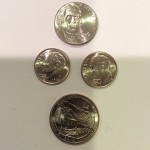
2014 coins found in change during a recent drive to New York
During one of our necessary stops, I was handed some change and noticed that the dimes looked a bit shinier than usual. Quickly zeroing in on the date I saw the “2014” date. After searching all over the Washington, D.C. area for 2014 coins, I find my first somewhere on the road in New Jersey.
Later that evening I emptied my pocket to see what else I could find. In addition to the dime, there was a 2014-P nickel and a surprise.
In 1979, the Susan B. Anthony dollar was released to much fanfare. It was the first “small” dollar coin and was the first U.S. coin to feature a real woman. Prior to the famed suffragette being featured on a coin, the image was that of Lady Liberty in some form. Even the Indian Head cent was not an Indian but Liberty in a native headdress.
But those of us who watch the experiment first hand soon discovered that the coin was too close in size with a quarter. In fact, the color, and reeded edges saw the Susie B. consistently being mistaken for quarters.
Almost as instantly as they appeared, the coins disappeared. Even as the public was willing to try the new coins, the rejection was almost as quick. After three years of production, the coins found a home in Las Vegas where they were used in slot machines. So many coins went unused following their last production in 1981 that was mainly for collectors, production picked up in 1999 after orders for additional coins were made from the vending machine and Las Vegas gaming industry.
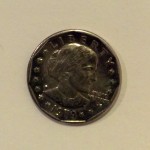
The ’79 Susie B. that I received in change that was probably mistaken for a quarter.
I suspect that someone who previously visited that roadside oasis (how’s that for a description of a rest stop along the New Jersey Turnpike), used one of the vending machines, then spent the dollar thinking it was a quarter. The coin sat in the tray in the cash register until it was time to provide change for my purchase. The cashier, not paying attention to what she was doing, counted the requisite number of coins from the quarter section of the draw. In a rush, I just saw what was the right size coin and dropped it into my pocket on my way back out of the building.
Starting in 2000, the dollar was changed to not only honor Sacagawea but magnesium was added to the metal mix to give the coins a golden color. The color and making the edge smooth made it less possible that the coin would be mistaken for a quarter. Unfortunately, the memory of the failed Susie B. lingers among a significant segment of the population in a way that kept a similar push with the modern Presidential dollars from being successful.
But in this case, finding a Susan B. Anthony dollar made my day!
Mar 19, 2014 | coins, dollar, medals, US Mint
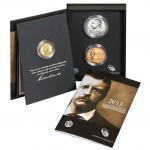
2013 Theodore Roosevelt Coin and Chronicles Set
After receiving the email, I could not remember what I ordered from the U.S. Mint that they are charging my credit card? I remember I made my annual order of presidential coin covers, but I received those. A visit to the U.S. Mint’s online catalog jarred my memory to remembering that I ordered the 2013 Theodore Roosevelt Coins and Chronicles Set. A quick visit to the webpage noted that the items will be available for shipping on March 18, 2014. I received the notice on March 18, 2014. This means the set should arrive within a week!
I usually do not buy the Coins and Chronicles sets because the subjects do not interest me. However, I have always been a fan of Teddy Roosevelt. My first exposure to Roosevelt was as a youngster growing up on Long Island, I was fortunate to have taken a few field trips to Sagamore Hill, his home in Oyster Bay, New York. My other exposure to TR was visiting the memorial to him at the American Museum of Natural History on Central Park West in Manhattan. Every time I go to the AMNH, which still my favorite museum, I make sure I stop in the TR Memorial.
Roosevelt initiated the “Golden Age of American Coin Design.” Using his bully pulpit, he held the designs of the U.S. Mint Chief Engraver Charles E. Barber in contempt. In fact, Roosevelt had called Barber’s designs “atrociously hideous.” Roosevelt ordered coinage whose designs were more than 25 years old to be redesigned. Roosevelt was a fan of sculptor Augustus Saint-Gaudens and asked him to help redesign American coinage.
After Saint-Gaudens died of cancer, Roosevelt continued to look to revitalize U.S. coinage. He seized upon Abraham Lincoln’s 100th birthday to redesign the small cent. He was steered to Victor David Brenner, whose bust of Lincoln was used as the model for the new Lincoln Cent first issued in 1909. Not only was Lincoln the first president to appear on a circulating coin, but Brenner’s obverse design is still in use today.
Roosevelt called his coinage redesign his “pet crime.”
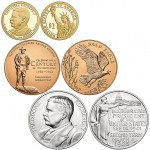
The coins and medals that are part of the 2013 Coins and Chronicles Set
If you want to learn more about our 26th president and have the time to read three books that were writing in Victorian-era prose, I would highly recommend the three books by Edmund Morris: The Rise of Theodore Roosevelt that covers his life up until his presidency, Theodore Rex about his presidency, and Colonel Roosevelt that discusses his life after he leaves office in 1909. For those who want a little lighter reading and in one book, I recommend Mornings on Horseback by David McCullough.
I have not yet read The Bully Pulpit by Doris Kearns Goodwin that covers the era of Roosevelt and his successor, William Howard Taft. Between Roosevelt and Taft, it was a time of bridging the Victorian era with the industrial age. It was a very interesting and important time in U.S. history.
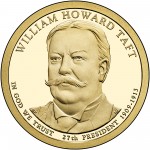
2013 William Howard Taft $1 Coin
For those in need of a good trivia question, Taft was the last president with facial hair, sporting a very cool looking handle-bar mustache.
All images courtesy of the U.S. Mint.
Dec 25, 2013 | base metals, cents, coins, commentary, dollar, Federal Reserve, gold, history, Morgan, Peace, silver, US Mint
Two discussions that transcended numismatics is what to do about the one dollar coin and common one-cent coin. Both coins cause different problems depending on who is doing the arguing. I find it amazing that the logic that is used to support the argument is not used consistently.
Dollar coins have been around since the beginning of the republic. In fact, the coin that currently holds the record for being the most expensive coin sold at auction is a 1794 Flowing Hair dollar. The coin is reported to be amongst the first dollar coins minted at the newly created Mint was bought by Legend Numismatics for more than $10 million. Laura Sperber, one of the principals of Legend Numismatics, was quoted as saying that she was prepared to bid higher for the coin.
If that is not enough to show how important the dollar coin has been in our history, there is always the 1804 Bust dollar, also known as “The King of Coins.” The U.S. Mint ceased to strike dollar coins in 1804 because of hoarding when the price of silver rose. The dollars that were struck in 1804 were struck using dies dated 1803 and are indistinguishable from the coins struck in 1803. The U.S. Mint continued to strike “minor coinage” to encourage circulation.
In 1834, eight dollar coins were struck with the 1804 date to include in a special set created as a gift for the King of Siam (the area known today as Thailand). One coin was included in the set, one was retained by the U.S. Mint for its collection that is now part of the National Numismatic Collection at the Smithsonian National Museum of American History, and the six others were kept as souvenirs by Mint officials and eventually landed in private collections. Between 1858 and 1860 seven more specimens were surreptitiously by U.S. Mint employee Theodore Eckfelt. It is alleged that Eckfelt created 15 coins. Six are in private collection, one is now part of the National Numismatic Collection and the others were reported to be destroyed when seized by the government.
The Coinage Act of 1873, known as “The Crime of ’73,” ended the free coining of silver and put the United States strictly on the gold standard until the western states where silver was being mined became upset. Two weeks later, congress passed the Bland-Allison Act to required the Department of the Treasury to buy the excess silver and use it to strike the Morgan Dollar. Morgan dollars, especially those struck at the branch mint in Carson City, Nevada are popular with collectors because of their ties to the days of the old west. Collectors can find quite a few nice examples of Morgan and the Peace dollars that were struck from 1921 through 1938 because many did not circulate. These coins were held as backing to silver certificates in circulation and did not get released to the general public until the GSA Hoard sales that begin in the 1960s.
Such a colorful history also has a downside that is used as fodder against the dollar. After ending the production of the Peace dollar in 1938, no dollars were struck until 1964 when the U.S. Mint struck 316,076 1964-D Peace dollars in May 1965. The coins were never put into circulation and the entire population of 1964-D Peace dollar were allegedly destroyed. There have been reports that some Peace dollars were struck using base metals (copper-nickel clad) as experimental pieces in 1970 in anticipation of the approval of the Eisenhower dollar. The same reports also presume these coins have been destroyed.
The Eisenhower dollar was not well received because of its size. The 38mm coin was seen as too big for modern commerce and with the exception of dollars struck with the special bicentennial reverse in 1975 and 1976, most coins did not circulate.
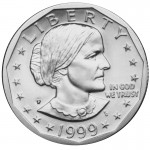
The Susan B. Anthony dollar coin was introduced in 1979 with much fanfare for being the first coin to honor a woman. The coin was a failure because it was confused with a quarter
Since the introduction of the Sacagawea dollar in 2000, the dollar coin’s size has remained the same but with the addition of manganese has a golden color to be visually different from other coins. For the visually impaired, the reeding was removed from the edges. Today, the Presidential $1 coins and the Native American $1 Coins have edge lettering that keeps it tactically different from the quarter dollar. However, people continue to bring up the Susan B. Anthony dollar as a reason not to use dollar coins.
Historically, dollar coins has been more popular in the western regions of the United States where the east prefers paper. Financial centers and big city government prefers paper for its alleged ease of handling. When circulated side-by-side, the public tends to choose paper over coin.
When we look around the world for examples of how to handle this situation, we find that the United States is the only country where the unit currency is available in both paper and coin. Other countries did not give people a choice. Rather, their governments made a decision based on overall economic benefits of using a coin with a predicted 30-year lifespan over paper currency that can last 18-24 months in circulation. Instead of the argument being of practical economics where every other country and the European Union have put on their proverbial long pants and made a decision that is in their best economic interest, factions in the United States comes up with mind boggling arguments of alleging that taking the paper dollar away is akin to taking away our freedom.
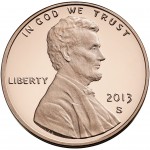
Obverse of the 2013-S Lincoln proof cent. Lincoln’s portrait, designed by Victor D. Brenner in 1909, is the longest running design of any United States coin.
The United States has a history of using its currency to boost the economic status of its citizens, aside from the various silver laws and the laws that eventually took the United States off the gold and silver standards, the creation of the half-cent was made because of the economic status of its citizens. Following Alexander Hamilton’s Treasury Secretrary’s report to congress “On the Establishment of a Mint,” Secretary of State Thomas Jefferson had another idea. Jefferson thought it would be better to tie subsidiary coins tied to the actual usage of the 8 reales coin. At the time, rather than worry about subsidiary coinage, people would cut the coin into pieces. A milled dollar cut in half was a half-dollar. That half-dollar cut in half was a quarter-dollar and the quarter-dollar cut in half was called a bit.
The bit was the basic unit of commerce since prices were based on the bit. Of course this was not a perfect solution. It was difficult to cut the quarter-dollars in half with great consistency which created problems when the bit was too small, called a short bit. Sometimes, short bits were supplemented with English pennies that were allowed to circulate in the colonies.
As an aside, this is where the nickname “two bits” for a quarter came from.
Jefferson felt that in order to convert the people from bit economy to a decimal economy, the half-cent was necessary to have 12½ cents be used instead of a bit without causing problems during conversion from allowing foreign currency to circulate as legal tender until the new Mint can produce enough coinage for commerce.
The half-cent would come into focus in the 1850s when the cost to produce the United State’s copper coins was nearly double their face value. In 1856, the Mint produced the first of the small cents, the Flying Eagle small cent, and produced 700 samples to convince congress to change to the small cent. As part of the discussion was the elimination of foreign currency from circulation making the U.S. Mint the sole supplier of coins.
There is no record of outcry from the public on the elimination of the half-cent. Its elimination came four years after the Coinage Act of 1853 that created the one-dollar and double eagle gold coins in response to the discovery of gold in North Carolina, Georgia, and California. The gold rush caused a prosperity and inflation that not only made the half-cent irrelevant but not something on the public’s mint. In that light, the Mint and congress felt that it just outlived its usefulness and would not be necessary with the elimination of foreign currency from circulation.
More controversy was generated in 1857 over the demonetizing foreign coins in the United States than the elimination of the half-cent. While the half-cent continued to circulate, it was estimated that one-third of the coins being circulated were foreign, primarily reales from Mexico. Redemption programs did not go smoothly, but in the end foreign coins were taken out of the market and the American people adapted and it could be said we prospered as a nation.
Like the 1850s, the last seven years have found that the cost of the copper used to make the one-cent coin has increased to more than the coin’s value. Combined with the labor and manufacturing costs, it costs the U.S. Mint between 1.6 and 1.8 cents for each copper-coated zinc cent struck. Although people argue that the cent is not needed and is barely useful, the U.S. Mint reports that 65-percent of its production are for one-cent coins that are ordered by the Federal Reserve to be circulated in commerce.
Eliminating the cent has caused controversy from those concerned with the economic welfare of the less fortunate. Many are using the same arguments that Jefferson made in 1791 to create the half-cent in order to keep the one-cent coin in circulation while others point to what other countries are doing. Canada is currently the country with the largest economy to eliminate its lowest denomination coin. Proponents of eliminating the cent point to Canada’s rocky success (withdrawal of the cent had been delayed twice) as an example of how the United States can handle the situation.
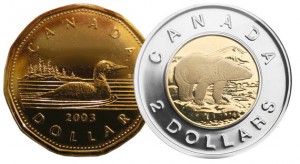
Canadian 1-dollar and 2-dollar coins. The 1-dollar coin is called a Loonie because its reverse depicts a common loon. “Toonie” is a play on the Loonie nickname.
Suggesting that if the United States follows Canada’s lead in the elimination of the cent, should the United States follow Canada’s lead and eliminate the one- and two-dollar Federal Reserve Notes in favor of one- and two-dollar coins?
This debate will continue until someone decides to act like an adult and make a definitive policy decision—especially when the Fed publishes a “working paper” that cherry picks facts to support a specific viewpoint.
Image of the Susan B. Anthony dollar and Lincoln cent courtesy of the U.S. Mint.
Image of the Canadian Loonie and Toonie courtesy of
Noticias Montreal.
Oct 10, 2013 | BEP, currency, dollar, Federal Reserve, news, video
 With the fanfare of a hard cough, the Federal Reserve released the new $100 Federal Reserve Note on Tuesday, October 8, 2013 to financial institutions. Various factors will effect how quickly these notes are seen in circulation including the demand and ordering policy of the financial institutions. In fact, the launch was introduced with a video by Sonja Danburg, Program Manager of the U.S. Currency Education Program at the Federal Reserve.
With the fanfare of a hard cough, the Federal Reserve released the new $100 Federal Reserve Note on Tuesday, October 8, 2013 to financial institutions. Various factors will effect how quickly these notes are seen in circulation including the demand and ordering policy of the financial institutions. In fact, the launch was introduced with a video by Sonja Danburg, Program Manager of the U.S. Currency Education Program at the Federal Reserve.
This launch is three years in the making as Bureau of Engraving and Printing reported problems with folding during the printing of the new notes. The announcement on April 21, 2010 said that the new notes would be released on February 10, 2011. On October 1, 2010, the Federal Reserve announced that the new note would be delayed. Later, the folding problems were revealed following a report released by the Treasury Office of the Inspector General.
The reason for the new notes are for the addition of security features. Aside from the ecurity thread, portrait watermark, color-shifting ink, microprinting, and the strategic use of color, the new note has a 3-D security ribbon and the use of color-shifting ink used to reveal a bell in the inkwell. If you look at the blue ribbon on the front of the note, tilt the note and watch the bells on the ribbon change to “100s” as the reflection of light changes. The 3-D ribbon is embedded in the paper and not printed. Looking at the copper-colored inkwell on the front of the note, tilting the note will reveal a bell that was embedded using color-shifting ink. Using these light sensitive features, the Federal Reserve hopes to significantly reduce the number of counterfeit notes, especially overseas where half of the $100 notes are known to circulate.
The Federal Reserve released a video about the new anti-counterfeiting features:
As an aside, the Bank of England recently announced that they will be transitioning to polymer banknotes by 2015.
Jul 30, 2013 | coins, dollar, fun
I found this poem by Clifford Johnson on a site named OpEdNews.com. It is worthy of everyone enjoying here:
S. 1105: Dollar Coins or Paper Dollars?
by Clifford Johnson
Coin or paper?
What a caper!
One is proper,
one a whopper.
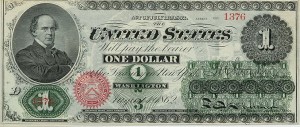
Drastic
is what’s inelastic,
plastic
more than gold’s fantastic.
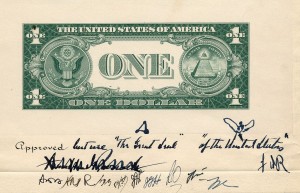
What is copper
to a shopper,
what a penny?
One too many.
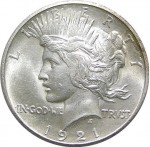
Paper powers
golden showers,
yet isn’t ours!
But a buck round
is square and sound.
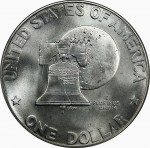
One is proper,
one a whopper.
Coin or paper?
What a caper!
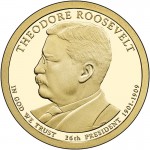
Images:
- First $1 bill issued in 1862 as a Legal Tender Note. (Wikipedia)
- President Franklin Roosevelt’s conditional approval of the one-dollar bill’s design in 1935, requiring that the appearance of the sides of the Great Seal be reversed, and together, captioned. (Wikipedia)
- 1921-D Peace Dollar. (Wikipedia)
- 1976-S Type 1 (1975) Eisenhower Dollar with Bicentennial Design. (Wikipedia)
- 2013 Theodore Roosevelt Dollar. (U.S. Mint)
Jul 22, 2013 | coins, dollar, legislative, policy
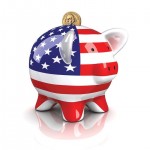
Dollar Coin Alliance
The COINS Act is designed to eliminate the $1 federal reserve note from circulation by increasing the circulation of coins and reducing the circulation of the paper currency over three years. At the end of three years, the Federal Reserve will not be allowed to distribute the $1 not. The bill does allow the Bureau of Engraving and Printing to continue to distribute the $1 note as a collectible for numismatists.
The bill was introduced by Sen. Tom Harkin (D-IA) and co-sponsored by Sens. John McCain (R-AZ), Tom Coburn (R-OK), Mike Enzi (R-WY) and Mark Udall (D-CO). It supports the GAO reports that suggest the potential savings of using the coin over paper will be $13 billion.
If you are in the Washington, DC area and what to talk about the COINS Act, the briefing will be held a noon at the Russell Senate Office Building in Room 385. Attending the briefing for the Council for Citizens Against Government Waste and The Dollar Coin Alliance:
- Aaron Klein, Former Chief economist for the Senate Banking Committee and Deputy Assistant Secretary of the U.S. Treasury
- William Christian, Director of Government Affairs, The Council for Citizens Against Government Waste
- Former Congressman Jim Kolbe (R-AZ), Honorary Co-Chair of the Dollar Coin Alliance
If you cannot attend the briefing, take the opportunity to contact your senators to let them know how you feel about the bill.
Logo courtesy of the Dollar Coin Alliance.
Jun 27, 2013 | coins, dollar, legislative
 Earlier this month, Sen. Tom Harkin (D-IA) introduced the Currency Optimization, Innovation, and National Savings (COINS) Act (S. 1105) to transition the United States to the use of a one-dollar coin rather than a paper dollar. Harkin introduced the bill with Senators Tom Coburn (R-OK), Mike Enzi (R-WY), John McCain (R-AZ), and Mark Udall (D-CO) as co-sponsors. The bill was assigned to the Senate Committee on Banking, Housing, and Urban Affairs. Only Sen. Coburn is a member of the Senate Banking Committee.
Earlier this month, Sen. Tom Harkin (D-IA) introduced the Currency Optimization, Innovation, and National Savings (COINS) Act (S. 1105) to transition the United States to the use of a one-dollar coin rather than a paper dollar. Harkin introduced the bill with Senators Tom Coburn (R-OK), Mike Enzi (R-WY), John McCain (R-AZ), and Mark Udall (D-CO) as co-sponsors. The bill was assigned to the Senate Committee on Banking, Housing, and Urban Affairs. Only Sen. Coburn is a member of the Senate Banking Committee.
This gang of five appears to have put a lot of thought into the bill in order to try to make the transition more palatable. The first provision of the bill is to remove Susan B. Anthony dollars from circulation within six month. Introduced with much fanfare in 1979 as the first U.S. circulating coins to feature the portrait of a woman, the Susie B.’s were an instant failure when they were mistaken for quarters. They were such a failure, some (alleged) journalists who does not know that the dollar coin was redesigned in 2000 to gristle when thinking of their past experiences.
When the coins are withdrawn from circulation (the bill calls them “sequestered”), they will be available for sale to coin dealers and can be sold to countries that use the U.S. dollar as its currency. Otherwise, these Susie B.’s will remain in legal and withdrawn by the banks when they are deposited. Although the bill does not provide explanation for these provisions, it can only be assume to prevent these coins from causing the confusion we experienced when they were released in 1979.
Aside from the circulation reporting requirements, the section encourages countries that have adopted the U.S. dollar to order coins from the Federal Reserve and for the member banks to only ship dollar coins. However, there are countries that have adopted U.S. currency as its standard that cannot afford the shipment of paper currency and have experienced a shortage of Federal Reserve notes for use in its daily commerce. The switch to coins will make shipping that much more expensive and may lead to a currency shortage in some countries.
As the Federal Reserve “sequesters” SBA dollars, the bill says that the Fed is to start replacing notes with coins but not completely. The bill allows both the notes and coins to circulate concurrently until more than 600 million coins are put into circulation or after four years, whichever comes first. Once the co-circulation trigger is met, the Fed will not be allowed to order currency for one year, thus reducing the supply of the paper note leaving people no choice but to use the dollar coin.
One interesting provision of the bill is that it does not completely eliminate the dollar note. According to the bill, the Fed may produce dollar notes “from time to time are appropriate solely to meet the needs of collectors of that denomination.” Much like the half dollar coin that does not circulate but is included in sets and made available to the collecting community, this will allow the Bureau of Engraving and Printing to produce special sets using one dollar notes in much of the same way they do with the $2 notes today.
A little noticed provision of the bill updates the handling of seigniorage that the U.S. Mint deposits into the United States Mint Public Enterprise Fund (31 USC § 5136). The revision simply allows congress to estimate the value of the seigniorage that will be deposited into the Public Enterprise Fund to be used for the budget process. Without this change, the government can only use the actual value in the account, which is the amount deposited in previous years.
It is probably not lost on these senators that since the Treasury pulled back on the production of dollar coins that the amount of seigniorage has decreased. If congress is going to force the dollar coin into circulation, it will increase the seigniorage the U.S. Mint will collect making those profits a prime target for the government to use for its own purposes. This provision will allow congress to attach those profits before being collected rather than waiting for them to be collected. Although this may not sound right, it is consistent with how congress estimates the collection of tax receipts for the current budgetary process.
Considering my recent experience in Canada using one dollar (Loonies) and two dollar (Toonies) coins, I would like to see this bill passed into law. Given the gridlock that congress has demonstrated by passing only 14 bills to this point of the 113th congress, one cannot be optimistic about congressional action.
Apr 30, 2013 | coin design, coins, commemorative, dollar, history
 Even though the Presidential $1 Coins have been relegated to collector coins, numismatists should celebrate the release of the Theodore Roosevelt dollar coin.
Even though the Presidential $1 Coins have been relegated to collector coins, numismatists should celebrate the release of the Theodore Roosevelt dollar coin.
Theodore “Teddy” Roosevelt, Jr. became the 26th President of the United States on September 14, 1901 following the assassination of William McKinley. Prior to becoming president, Roosevelt was a deputy sheriff in the Dakota Territory, Police Commissioner of New York City, U.S. Civil Service Commissioner, Assistant Secretary of the Navy, and Colonel of the Rough Riders for which he was awarded the Medal of Honor. Roosevelt was elected to the New York State Assembly, Governor of New York, and Vice President of the United State. In fact, his nomination as vice president to run with William McKinley by the Republican Party was to get him out of New York because he was reforming the status quo out of existence.
On September 14, 1901, at 42 years and 322 days of age, Roosevelt became the youngest President when McKinley was assassinated (Kennedy was the youngest elected president when he was inaugurated at 43 years, 236 days). As president he was a trust buster, conservationist, and his slogan of “Speak softly and carry a big stick” set the tone for military and foreign policy that even impacts today’s policies. Roosevelt was the first U.S. citizen and sitting president to win the Nobel Peace Prize for negotiating the 1905 peace treaty ending the Russo-Japanese War.
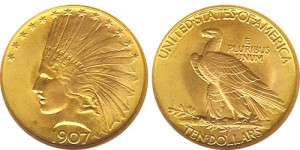
Augustus Saint-Gaudens designed the $10 Indian Head gold eagle that was first released in 1907.
After Saint-Gaudens died of cancer, Roosevelt continued to look to revitalize U.S. coinage. He seized upon Abraham Lincoln’s 100th birthday to redesign the small cent. He was steered to Victor David Brenner, whose bust of Lincoln was used as the model for the new Lincoln Cent first issued in 1909. Not only was Lincoln the first president to appear on a circulating coin, but Brenner’s obverse design is still in use today.
Roosevelt called his coinage redesign his “pet crime.”
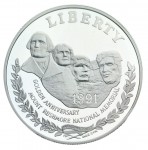
1991 Mount Rushmore Golden Anniversary Silver Dollar
Interestingly, the 2013 Mount Rushmore National Memorial quarter that will be released later this year will only show Washington and Jefferson during its sculpture. Lincoln and Roosevelt are not part of this image.
Teddy is now featured on the current one-dollar coin. The coin has a portrait Roosevelt facing to his right that even gives the impression of someone looking into the distance. It is fitting for a man who was always looking forward to preservation of America’s ideals and its place as a world leader.
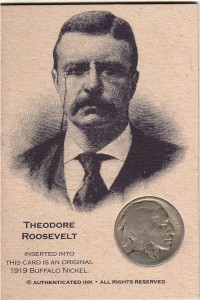
Teddy Roosevelt is my favorite president for many reasons including his view on coin designs. BULLY!
Credits
- 2013 Theodore Roosevelt Dollar and 1991 Mount Rushmore Golden Anniversary Commemorative Silver Dollar images courtesy of the U.S. Mint.
- Image of the 1907 Indian Head $10 Gold Eagle courtesy of U.S. Rate Coin Investments.
- Theodore Roosevelt card with 1919 Buffalo Nickel property of the author.
Apr 2, 2013 | BEP, coins, currency, dollar, Federal Reserve, fun, US Mint
Based on some responses in my Twitter feed and via email, a number of people forgot what day it was and did not read yesterday’s post carefully.
To understand the post’s true condition, you have to consider the following:
- The Chairman of the Federal Reserve is Ben S. Bernanke. His first name is really Ben, not Benjamin.
- The law requires the Federal Reserve to distribute the one-dollar note. Only congress can vote to stop producing the note.
- The Acting Director of the U.S. Mint is Richard A. Peterson, not Pederson.
- Seignorage is deposited in the Public Enterprise Fund. No, the leaving out of the “d” in the original post was not a typo because I was having fun!
- The Director of the Bureau of Engraving and Printing is Larry Felix. I do not know a Larry Felinks. Maybe he is a long lost cousin of the director?
- The company that supplies currency paper to the BEP is “Crane and Company.” The Sandhill Crane Company does not exist, but there is a bird called the sandhill crane. There is also a blue crane, but I am reasonably sure that there is no such person as Violet “Blue” Crane; or at least there is not one associated with Crane and Company. Maybe there is a Blue Crane working for Sandhill Crane? There is a joke in there that can use “Whooping Crane” which I will leave as an exercise to the reader!
- Finally, when was the last time you heard the Fed Chairman concerned with coin collectors? The last line was added to emphasize the date.
In other words:
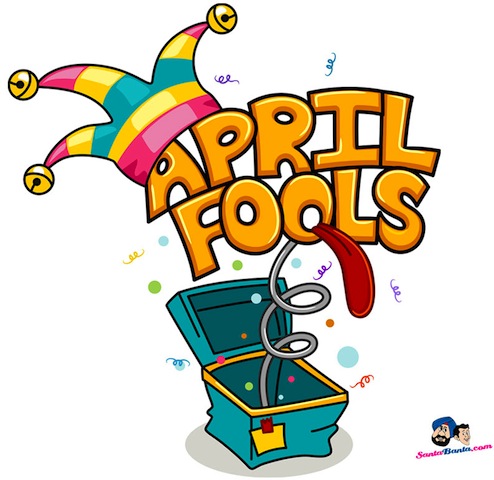
Besides, who is giving a blogger an exclusive story that does not appear elsewhere? Like the Orson Well’s broadcast of The War of the Worlds, all you had to do is change the channel (or check another source).
That was fun!
Now back to our regular numismatic content.
Apr 1, 2013 | BEP, coins, dollar, fun, US Mint
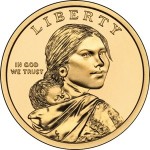
Obverse of the 2009-present Native American Dollar
“We have so many dollar coins, it makes sense to find a way to get them into circulation,” Bernanke said. “It will also help reduce the storage requirements to hold these coins.”
Bernanke, who has been both complemented and reviled over the Fed’s handling of the Great Recession, said that now that the economy was more solid, he would turn his attention to doing what he can for the federal government. Citing the GAO report that estimated the federal government could save at least $4.4 billion by using coins rather than money, Bernanke will use his power as Chairman of the Fed to determine the independent bank’s policy over circulating money.
“Not only will this keep our facilities busy but it will help the U.S. Mint maintain and increase its profitability,” said Richard A. Pederson, Acting Director of the U.S. Mint. “The reduction of dollar coins previous ordered by [then Treasury Secretary Tim] Geithner really hurt our bottom line. It significantly lowered our seigniorage and the size of our deposit into our Public Enterprise Fun.”
Pederson assured Bernanke that the U.S. Mint will be able to meet the new demand for circulating dollar coins.
Director of the Bureau of Engraving and Printing Larry Felinks said that this change will help increase productivity in other areas of their operation. “Printing of the one dollar note is over 50-percent of our production. This reduction will allow us to concentrate on other projects including trying to figure out why we have not been able to produce $100 notes.”
“Obviously, we are not happy about this,” said Violet “Blue” Crane, family spokesperson for the Sandhill Crane Company who manufactures the paper for the Bureau of Engraving and Printing. “Manufacturing paper for the one dollar bill was half of our business and gave us the most profit since that paper did not have to include anti-counterfeiting features.”
The U.S. Secret Service declined to comment for this story and any other story they were asked about.
Bernanke, sitting in his office obviously pleased with his new policy, also understood the impact of his decision on the numismatic industry. Leaning back in his chair, Bernanke closed with, “Collectors of United States coins will remember April 1, 2013 as the day I gave their dollar coin collection more meaning.”
Native American Dollar image courtesy of the U.S. Mint.




















